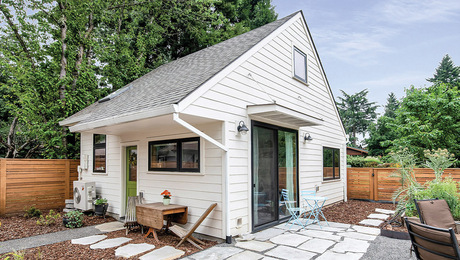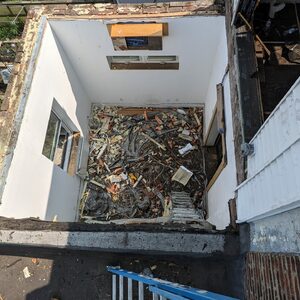I have a basic question for the experts out there regarding metal roof installation. I am building a wood shed and I am planning to cover the roof area with some metal roofing I can get at the local HD. The roof area is just small 2×4 joists 8′ long running 16″on center and 1×3 strapping perpendicular to the joists every 2 feet. It will contain nothing else. The whole roof is 12×8 and only one straight side so it is straight sheets overlapping each other.
My question is when the roofing gets screwed to the strapping is there any special gaskets or caluking I should use? Do you predrill the holes before installing? It’s just just a wood shed but why not build it right? I just don’t want it to leak. How much should you overlap each sheet?
Thanks for you help in advance.
Michael



















Replies
They make hex head screws with a rubber gasket already on them for metal roofs. Available pretty much anywhere like Lowes or Menards, or Home Depot.
Ovelapping the seams usually is just one rib. The roof is small enough so that you won't have to overlap 2 sheets to make it to the ridge.
What's wrong with me? I could ask you the exact same thing.
You should get a set of installation instructions with the roofing. If not located with the material stack, ask the people at the counter to get them for you. The instructions will tell how to lap the metal and where to place the screws.
What you will be getting is likely 26 ga. metal and you want the color matched screws with neopreme washer on them. No, you do not need to predrill for the screws, They are self drilling/self tapping with a 1/4" hex drive head. The important thing, to avoid leaks, is to not over drive the screws and crush the washer.
Others will follow with more advice.
Dave
I agree there should be an install sheet with the product, but6 he is buying from a big box...29 GA has become very common. I stil prefer and spec 26GAI preddrill my holes. It is easier with the material stacked together on the ground, and ensures that they all line up neatly. Maybe not appropriate for this job ( small shed and perhaps not straight strapping - BTW, I have never used such small purlins to screw the steel to)I also predrill slightly larger diamerter than the screw size. The neoprene washer set right takes care of leaks and the oversized hole helps with expansion/contraction. I use the screws with 5/16" head. In the long run, they do better, don't snap off as easy and have more displacement of wood for greater holding ability
Welcome to the Taunton University of Knowledge FHB Campus at Breaktime. where ... Excellence is its own reward!
I would just like to add that I would predrill my over lapped sheet just so the screws line up when you look up at the roof and for ease in screwing them together. It's alot easier to screw through one sheet than two. Don't drill the bottom sheet because sure enough the holes will be off just enough to mess with you. I normally just use an 1/8" bit for that and you should be able to drill through about ten sheets at a time.
Also I would predrill the ridgecap and gable end trim also. Same reason as before.
Good Luck, Dave
talk to Piffen, he's the expert
As usual all good advice. i had seen the screws near the sheets of metal with the gasket on them at HD. they looked pretty pointed /sharp so i figured they were self tapping. But better to be safe and ask questions rather than screw up an installation (no pun intended). I just didn't know if there was any kind of gasket that went between the sheet metal and the strapping.
Also good advice on screwing the overlap. Thanks very much.
One more question, should I place the screws in the "valleys" of the metal or on the "peaks"? My guess would be the "peaks"....
thanks again everyone. much appreciated.
Michael
Valleys. They have found that the ones on the peaks work themselves out sooner than in the valley. Also you only need the 1" screws as opposed to the 1 3/4" for the peaks.
I have used #15 paper on the strapping before, just as a water barrier since the metal will condensate.
Just a thought.
Dave
Edited 8/2/2006 5:59 pm by DaveMason2
The gasket is already on the roofiong screw.They go in the flats. There is no need to screw anything on the ridges, especially the lapping one. What you do have to pay attentiuon too is the male side of lap goes over the female side. Doing it that way, there is a drip catch that funnels water away down the roof. Get it backwards and you can trap water in the lap aas well is make it look goofy. This reversal of the proper lapping is the most common DIY mistake I see. It can cause leaks.
Welcome to the Taunton University of Knowledge FHB Campus at Breaktime. where ... Excellence is its own reward!
is this corrugated, ribbed, or standing seam?
Welcome to the
Taunton University of Knowledge FHB Campus at Breaktime.
where ...
Excellence is its own reward!
Hi Piffin,
the metal roofing is corrugated. I will take note of the male/female overlap to stop any leaks. Yes the purlins are a bit small but it is just a wood shed and I truly don't expect it to hold alot of weight. They were secured quite well. The roof pitch drops 4 feet over an eight foot span , so it's a pretty steep angle to boot. The oversize hole for expansion/contraction also sounds like a good idea. I will be particularly careful to make sure the screws and gaskets cover the holes correctly.
Are there any suggestions on what to do if you have to cut one of these sheets? A circular saw with a metal cutting blade or tin snips or something else?
Thanks again to all.
Michael
I take back half my advice. It was predicated on my assumption that it is the ribbed panels which aare the most common.For corrugated, there is no male/female difference, and the screws go in the high spots instead of the valleys normally.tin snips will spread the metal pattern out.
I would try nibblers on corruugated.
Welcome to the Taunton University of Knowledge FHB Campus at Breaktime. where ... Excellence is its own reward!
Another tip-When you set the new sheet up there to fasten, clip the top and bottom lapped to the previous one with vise grips to hold it in place while you screw
Welcome to the Taunton University of Knowledge FHB Campus at Breaktime. where ... Excellence is its own reward!
A saw with metal-cutting blade will work just fine for cutting. I like to make crosscuts so the cut edge is on the upslope end of the sheet, thus it will be covered by either a lap or flashing. Wear eye and ear protection.
You'll be using screws like this, predrilling a small hole through high ribs to hit the purlins. See the rubber washer? No need for oversized holes . . . in fact, don't do it.
Your edge laps will use a rubber washered screw, same head, but short, and with coarse sheet metal threading. Your predrilled hole will want to have a diameter slightly less than the root diameter of the screw.
View Image
Something to consider if your metal has any kind of profile to it and isn't over solid sheathing: insect/ventilation screen. At the eaves and underneath the ridge cap piece there will be gaps for insects and small mammals to crawl through. Our local metal roof supplier sells rolls of batting that fit the roof profiles.
Lots of good advice; some conflicting points of view but there are many ways to skin a cat. Just for the record, I screw into the ribs as that's what the mfg specs for the brand most commonly used up here. If I don't, it's a warantee issue. (Also, and more importantly, it works.)
But you're on corrugated anyway, so it's a moot point. Screw into the ridge, not the valley. Real corrugated roofing is heavy, galvanized metal, not 30ga crap like they use nowadays. You will definitely want to pre-drill this stuff. Watch it with that 1/8th inch bit; they're easy to snap (ask me how I know...).
One thing you asked which no one mentioned is what to put in the lap joint between the adjoining sheets. You need to get some butyl rubber caulk like this stuff:
View Image
View Image
If you go to http://www.mulco.ca you can log onto the English version of the website and check the specs, but basically it is a true butyl rubber caulk, not a plastic, latex, or silicone. It remains flexible down to minus 30ºC, is inexpensive, and is very easy to apply with a pneumatic caulking gun (although for a small project like yours you could use a manual gun; you probably won't have more than two or three sheets per side).
Squirt a 3/8" bead of butyl all the way down the valley that will lap, on the underside of the upper piece, then lay it on top of the lower piece and screw down. It won't leak.
If you don't do this, capillary action will wick water sideways up into the lap joint whereever leaves and crud block or slow drainage, and cause it to leak through the screw holes (because the water will enter the holes beneath the neoprene washers on the screws). This will eventually rot your purlins at the screw penetrations and the first good windstorm will rip the metal right off the roof.
Dinosaur
How now, Mighty Sauron, that thou art not brought
low by this? For thine evil pales before that which
foolish men call Justice....
RESULTS:
We had wonderfully cool weather in the White Mts this past weekend . I picked up the corrugated sheeting from HD, got the screws, got the caulking, got the drip edge for the top of the shed (which allowed me to "cheat" a little from the top by 2" - the drip edge was 5-6") and a couple of new 1/8" drill bits and put it all together on Saturday.
It was a pretty easy process amd only included about 7sheets to be installed. I took my time and used the vise grips to clamp the sheets together for predilling the overlap edge and also for holding the sheets in place while I screwed them down. All the suggestions were well heeded and appreciated. Screws went in far enough but not too far (i hope). Big box only had 1/4" head screws so I had to work with what they gave me (no 5/16" heads). Hopefully everything works out. I was happy with how it all turned out. Not bad for a beginner.
I thank everyone for your help and suggestions. You guys are the best.
Mick
Glad we could help.Dinosaur
How now, Mighty Sauron, that thou art not broughtlow by this? For thine evil pales before that whichfoolish men call Justice....